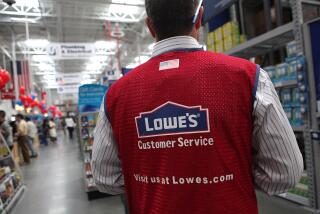Affirmative Action Finally Wins Grudging Acceptance
WASHINGTON — Edward Gaffey, a young white police recruit in Boston, fears that the department’s affirmative action program could hold back his career, but he concedes that increasing the number of minority officers is a worthy goal and admits he “can’t think of anything else” to achieve it.
Ralphael Brown, a planning manager at Monsanto Co. in St. Louis who finds hiring quotas essential to the advancement of blacks such as himself, nevertheless concedes that Gaffey has a point. “I can understand where he’s coming from,” Brown said.
After years of bitter controversy, affirmative action in the workplace--deliberate favoritism toward minority groups and women to compensate for generations of discrimination--has achieved a grudging acceptance among American workers and employers alike. Despite continuing sharp criticism from the Reagan Administration, the anxieties created when minorities and women first received preferential treatment in hiring have begun to fade away.
“The world didn’t come to an end and the walls didn’t tumble down,” said James Burton, Monsanto’s equal opportunity affairs manager. “As a result, we’re seeing a different attitude toward looking at people as individuals.”
The National Assn. of Manufacturers, which represents 13,500 corporations, told a congressional committee July 10 that work force diversity resulting from affirmative action has “produced new ideas, opinions and perspectives in management, product development and marketing.”
Peter Robertson, a Washington consultant on affirmative action to 215 of the nation’s largest corporations, said a survey shows that 95% of those firms plan to continue their efforts regardless of what the government does.
But the battle over quotas and other tools of affirmative action is far from over. Sporadic charges persist of reverse discrimination against white males, and of incompetence among minorities and women hired under affirmative action. And, if the workplace has largely become reconciled to affirmative action as a tool for hiring, the next step--progress for minorities up the promotional ladder--has become a new source of tension. It is what affirmative action experts call “the second generation issue.”
The big question now “is not so much whom you hire as what happens after you hire them,” Robertson said.
Affirmative action dates to the 1964 Civil Rights Act, which established the federal Equal Employment Opportunity Commission to investigate complaints of workplace discrimination and authorized federal courts to order employers to take steps to overcome the effects of past discrimination. Those steps could include quotas--requirements that, for example, one minority group member be hired for every new white worker added.
Johnson Issues Mandate
A year later, President Lyndon B. Johnson ordered large federal contractors to demonstrate progress toward diversifying their work forces, although strict mandatory quotas were not part of Johnson’s executive order.
The result was a burst of complaints about racial discrimination in the workplace--the EEOC receives tens of thousands each year--and a burgeoning of affirmative action plans.
Between 1974 and 1980, according to the Labor Department, the number of minority workers employed by firms with federal contracts--and thus subject to the government’s policy--grew by 20%, compared to a 12% increase in firms not involved in government work and having no affirmative action plans established. For women, growth was 15% against 2%.
At the same time, complaints about the effect of such plans on white males began to rise. The EEOC received 1,556 formal charges of reverse discrimination by public employers alone from 1979 through 1983, for example.
Paul Bearden, a 48-year-old white firefighter in St. Louis, says affirmative action there has “created a lot of hard feelings.” Bearden, still a private after 23 years on the job, said he once aspired to captain’s rank but, in the wake of affirmative action, has quit studying for the test.
‘I Don’t Like the Odds’
“I don’t like the odds. . . . I feel a lot (of blacks) would not be as qualified as I was,” said Bearden, a pensive man who works in shop maintenance and says he associates freely with black firefighters.
Some affirmative action officers have been accused of overzealousness, of hiring “basket cases” solely in order to meet quotas. William McCarthy, a white Boston police officer, charges that the force has actually hired criminals and illiterates in its effort to boost minority numbers. “I think your professionalism and your standards are being dropped down,” he said.
Larry Brown, a black officer and spokesman for the Massachusetts Assn. of Minority Law Enforcement Officers, calls that view racist. “Considering some of the white male police officers we have on this job, that’s like--excuse the pun--the pot calling the kettle black,” he said.
And Verna Brookins, Polaroid Corp.’s manager of community relations in Boston, contends, “The door was open because I was black, and the door was open for you (whites) years before because your father worked for your grandfather and mine didn’t.”
Opponents Given Boost
But opponents of affirmative action were given a big boost by the Reagan Administration, which contends that hiring and promotional preferences based on race or sex are inherently unfair and discriminatory.
Earlier this year the Justice Department asked 51 state and city governments, including Los Angeles, San Francisco and San Diego in California, to alter existing plans for hiring and promoting women and minorities, usually in police and fire departments.
The Justice Department based its action on a 1984 Supreme Court decision holding that Memphis, Tenn., had violated the seniority rights of white firefighters when it retained junior black firefighters and laid off whites with more seniority. What applies to layoffs, the Justice Department reasoned, should also apply to hiring and promotion.
Not surprisingly, the Justice Department position proved controversial.
Joseph Madison, national director of political action for the NAACP, said the Administration “reminds me of Michael Jackson doing the moon walk--giving the impression of going forward while really going backward.”
Bradley Voices Concerns
Los Angeles Mayor Tom Bradley charged that the Justice Department’s approach “will result in expensive, time-consuming litigation and will reopen old wounds that have long healed.”
The U.S. Conference of Mayors, which represents 550 cities with populations of 30,000 or more, adopted a resolution last month in support of affirmative action programs unless there is “a clear repudiation by Congress or the judiciary.”
No such repudiation is yet apparent. Five of the nation’s 13 federal appeals courts, including the U.S. 9th Circuit Court of Appeals in California, have held that the Memphis firefighters’ case, which involved layoffs, does not apply to affirmative action plans involving hiring and promotions.
The Supreme Court’s last word on such plans came in 1979 when it ruled against Brian Webber, a white steel worker who protested that a special training program for blacks at Kaiser Chemical & Aluminum Corp. was racially discriminatory.
There is disagreement even within the Reagan Administration. Last month Labor Secretary William E. Brock III told the annual convention of the NAACP in Dallas that the country will need “some form of affirmative action for a considerable period of time into the future. . . . We as a country have lived for 200 years with a major part of our population in remarkable disadvantage, and it takes some time to recover from that.”
Improved Practices Cited
Many private employers say affirmative action has forced company managements to improve their personnel practices and build good will among minority and women employees and job seekers--not to mention minority and women consumers of their products.
“If this whole place was staffed with white Anglo Protestant Midwesterners, I would suspect that our dealings in the world would be somewhat constrained,” said Francis Reining, a general manager at Monsanto. “The fact that we have a calico complexion is beneficial to doing business throughout the United States and the world.”
Madison of the NAACP, which has pressured firms to employ more minorities, said: “I challenge anyone to find any of the chief executive officers of the Fortune 500 companies who would publicly denounce affirmative action. The benefit has been tremendous in that it has broadened the pool of talent.”
Some Harbor Resentments
In addition to opening up opportunities, affirmative action has also bred an uneasy feeling on the part of many blacks that they won their jobs not on merit but because of the color of their skin. Some believe they have been hired not to do a job but to fill a quota--and they resent it.
James Burton, now Monsanto’s equal opportunity affairs manager, said that when he was hired in 1966, he was “a number.”
“I had a job as a supervisor for something called security education, and all I was expected to do was to sit around and look pretty all day,” he said.
In Burton’s case, Monsanto’s attitude toward its black employees changed as the company gained more experience with affirmative action. “I can’t put my finger on it, but the management got religion,” he says. He was assigned more meaningful duties, and “my feet were put to the fire.”
Burton is among the fortunate. Glenn Loury, a black political economist at Harvard, warned that affirmative action leaves black achievements “enshrouded in suspicion that the attainment is partly due” to hiring goals. Affirmative action “will be costly to black people in the long run,” he said, because it “undermines the will and energy to achieve.”
Blacks Worry About Careers
Other blacks concede that some unqualified persons have been hired in the interest of boosting minority employment, and they worry about the impact on their own careers.
“They’re looking for the street kids to get jobs,” said Jim Williams, a black police officer patrolling the Boston Common on horseback. “And it strikes me funny that, if you’re an angel, they don’t want you to work. If you’re a bad kid in the street, that’s the kind that they want working the job.”
Dennis Saunders, a black firefighter in St. Louis, complains that white officials have hired “bottom of the barrel blacks so they could fire them later. They’re not hiring you to keep you.”
In Boston, Albert (Dapper) O’Neil, a white City Council member with a Jackie Gleason voice, has no use for women in the police and fire departments. “I looked at some of them: 5-foot-1, 97 pounds. I mean, what are we doing here?”
As O’Neil sees it, the public safety is threatened. “I’ve got a lot of men out injured because their partner was a woman,” he complained. “The woman will always run and say, ‘I’ll get some backup, you take care of it. I’ll be right back.’ In the meantime, he’s flattened.”
Kathleen O’Toole, one of 95 women among the city’s 1,620 police officers, scoffs at that view. “In policing,” said O’Toole, a lawyer who is 5 feet, 8 inches and weighs 135 pounds, “99% of the job is being able to use good common sense, use your head in any given situation. . . . I worked with some old-timers who could barely make it out of the cruiser.”
She recalls the time she and a 60-year-old male partner were running after a suspect. She said her partner, whom she called “a real great guy,” slowed and panted, “Go get him.”
Laura Montgomery ran into overt resistance from Alan Phillips and Scott Shisler, two sales supervisors for Monsanto, when she was promoted to a sales supervisor position last November. Phillips and Shisler, both bright and ambitious, had gained entry into management by the traditional path--serving first as salesmen in the field. They suspected that Montgomery, a Harvard Business School graduate with no sales experience, got her promotion because Monsanto needed to meet a goal under its voluntary affirmative action program.
Wants to Head Monsanto
But now, after eight months of working side by side, Phillips and Shisler are more than reconciled to Montgomery’s presence. Phillips says confidently that he is “not intimidated by the fact that at some point EEO (equal employment opportunity) may deny me an opportunity. From what I’ve seen, if my potential for doing the next job is better than anyone else, I’m going to get that job.” And as for Montgomery, who is unabashedly shooting to be head of Monsanto some day, she says that once her colleagues “find out you’re talented and competition for them,” things are “great.”
Monsanto, which over the last 20 years has doubled the percentage of its minority employees to 13%, is committed to affirmative action. But like most firms, Monsanto’s minorities are concentrated in the service and labor divisions, and they constitute only 6% of the managers. Women, now 24% of the work force, predominate in the clerical jobs and account for only another 6% of the managers.
Of the 30 top management positions, Burton said, one is held by a Latino and none by a woman. He says 350 “key positions” below those include eight members of minorities and six women.
Predicts Dramatic Increase
Burton said the numbers will rise dramatically as minorities and women increase their tenure in lower-level jobs. He says management is “looking in the pipeline now for those who have been here for, say, 10 years or more and trying to groom them.”
If affirmative action has proceeded smoothly at private employers such as Monsanto, it continues to generate ill will elsewhere.
Consider the St. Louis Fire Department, which is under a court-supervised consent decree with black firefighters to hire one minority group member for each white until the makeup of the department, like that of the city’s overall work force, is evenly divided between the races. That goal remains a long way away; at the end of last year, 600 of the city’s nearly 800 firefighters were white.
William Duffe, St. Louis’ personnel director and a white, had this to say about the city’s white firefighters: “I have never seen such a bunch of bigoted hardheads as these people. . . . They are really hard-core racists. Most people these days at least kind of cover it up; they talk in hushed tones. But these guys yell it out on street corners and, from what I hear, other cities have problems with police and fire in the same way.”
Problems Confront Boston
Boston certainly does. Consent decrees require the Police Department to promote more minorities to the rank of sergeant and the Fire Department to bring minority employees up to the one-third percentage they represent in the city’s overall work force.
Both departments have a long way to go. Of the Police Department’s 148 sergeants, three are minorities and four are female. And, although half the new hires by the Fire Department last year were minorities, the city’s 1,573 firefighters still includes only 255 blacks, 36 Latinos and three Asians.
More to Read
Inside the business of entertainment
The Wide Shot brings you news, analysis and insights on everything from streaming wars to production — and what it all means for the future.
You may occasionally receive promotional content from the Los Angeles Times.










